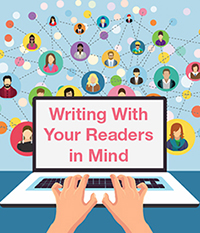Writing With Your Readers in Mind


Your clients, unlike fellow lawyers and judges, don’t have legal training. When they visit your website they want information they can understand. Your priority should be to help them rather than impress them with your knowledge. To do this, you must know your target market, the purpose of your publication, and use style and structure techniques for clarity.
The Reader
Who are the clients you’re writing for? Consider their occupations, age range, level of education, or experience in the field. Write from their viewpoint. Realize that your readers are seeking information about a pressing legal problem that is causing stress in their lives. They may be rushed and searching late at night or on their lunch hour. To help them, present the information to be easily understood.
Help the Reader
The headline and the first one or two sentences are the most valuable, so make them attention grabbing. Often you can get and keep the reader’s interest by creating a short story to set up the topic. Change legalese into plain English and replace long phrases. Create white space with shorter paragraphs, bullet points, boldface, lists, or subheads. Keep sentences to twenty words or less.
Because the primary position of importance in the English sentence is the end, try to conclude that first and every sentence forcefully to keep the reader interested. The second most valuable part of your article is the final paragraph, so remember include your “call to action,” telling readers what you want them to do.
The Publication
Your web page, practice pages, about us page, and blog posts are the most read parts of your marketing materials. Each has a purpose. The practice pages describe the services your firm provides. Your bios give information about the lawyers in the firm. Blog posts keep clients up to date on recent developments in the law, new services being offered, or changes in staff members. Your quarterly newsletter, whether printed or electronic, is more formal than a blog. Each is written with your target market in mind.
Style & Structure
- Edit unnecessary words. Using fewer words improves speed, clarity, and impact. Adding more words slows the reader down.
- Use action verbs. Instead of saying "The bill was passed by the legislature," try "The legislature passed the bill" Or, rather than "Billy was arrested by the FBI," use "The FBI arrested Billy."
- Review the article. Did you start with the most important part? Read the story out loud to find trouble spots.
- Sleep on it. Stephen King advises putting the manuscript in a drawer for six weeks to age. You might not have that amount of time, but even a few hours can make a big difference.
Clean Up
Have fun with it. It’s not a brief for a judge or opposing counsel. It’s information for your clients.
 After years practicing law, Roberta Gubbins served as editor of the Ingham County Legal News. Since leaving the paper, she provides writing services to lawyers ghostwriting content for websites, blogs, and articles. She is editor of The Mentor, the SBM Master Lawyers Section newsletter.
After years practicing law, Roberta Gubbins served as editor of the Ingham County Legal News. Since leaving the paper, she provides writing services to lawyers ghostwriting content for websites, blogs, and articles. She is editor of The Mentor, the SBM Master Lawyers Section newsletter.
Read More Clear & Convincing Articles
Using the Enhanced Member Directory
How to Login and Edit Your Profile
CloudLawyers Directory Services
How to Contact CloudLawyers Support